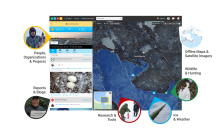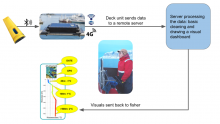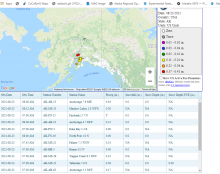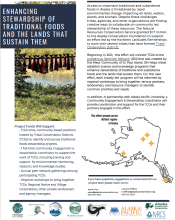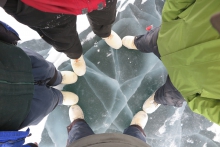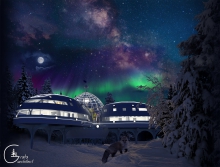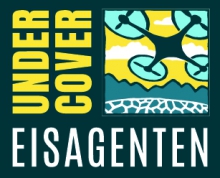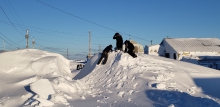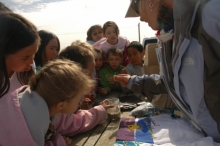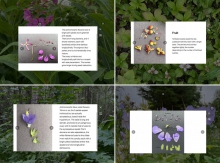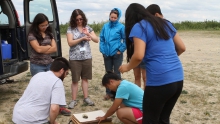Abstracts are organized below by talk type (Keynote, Plenary, Lightning, Panel, Pre-recorded), and then alphabetically by talk title within each talk type, with the exception of Keynote talks organized by day. The presentations are now archived on YouTube.
Keynote
DAY 1 – SIKU: The Indigenous Knowledge Social Network—Tools and Services Supporting a Leading Role for Northern Communities in Research and Monitoring
SIKU, the Indigenous Knowledge Social Network, is an online platform and mobile app designed by and for Inuit. SIKU supports Inuit self-determination in research, education and environmental stewardship by offering tools to monitor environmental change, map hunting trips and dangerous ice conditions, and share knowledge in a variety of languages, all while providing users full ownership over their posts and data. This presentation summarizes Arctic Eider Society’s ongoing engagement with SIKU’s growing user base over 2021, and future outlooks towards the platform’s role in supporting climate change adaptation across northern communities. The 2021 Goose Watch and Ice Watch Competitions drew participation from ~30 communities, allowing contributors to collectively track wildlife migrations and sea ice conditions across the Canadian Arctic. SIKU has also been a major tool for community-driven research across Inuit Nunangat, involving members of several communities documenting hunting trips and land use activities through their posts. Upcoming features include new tools for sharing Inuit knowledge around climate change in an expanded platform called SILA for SIKU. Finally, we look forward to this presentation as an opportunity to gather additional input and learn ways that SIKU may best facilitate the needs of contributors and Indigenous organizations among northern Alaskan communities.
DAY 2 – Why It’s so Hard to Solicit Buy-in from Arctic Communities in Arctic Research
One of the largest obstacles that “Arctic research” has dealt with in recent years is not necessarily related to environmental observations or climate change. Rather, many Arctic scientists and researchers struggle with the inability to develop relations and trust with rural Arctic residents and their representative entities. Funding requirements are awash with protocols, guidelines, and mission statements that call for deep inclusion of Arctic residents in Arctic research projects. However, this deep engagement between Arctic residents and Arctic researchers has proven extremely difficult to apply in practice. This is especially true for Arctic “Community” and “Citizen” science projects that require local involvement in rural Arctic communities. This presentation focuses on why it is so hard to solicit buy-in from rural Arctic communities in Arctic research. First, the presenter will provide historic context regarding US Arctic research that impacts research-resident relations in Alaska before 2020. Second, the presenter will look more closely at how researcher-resident engagement efforts were impacted by the COVID-19 pandemic. And third, the presenter will highlight real examples of on-going projects that have had success in engaging communities, in addition to new ideas to potentially foster positive forward movement in Arctic community and citizen sciences.
DAY 3 – Alaska Berry Citizen and Community Science - A Decade of Science, Learning, and Navigating the Program Design Tradeoffs Between the Two
Changes in the growing seasons in the Far North have influenced the timing, abundance, and quality of our berries. This can have consequences for people who pick berries in the fall, and for migratory animals and winter resident animals that rely heavily on berries for food in fall, winter, and spring. Over the past decade, the University of Alaska Fairbanks has operated a series of citizen and community science projects that investigate different phases in the life cycle of tundra and boreal forest berry species. The programs have engaged over 1700 volunteers in many dozens of communities, school and youth groups, families, and organizations across Alaska, and important science and learning has come out of these projects. Through these projects, we have experimented with program design models to reduce the often-cited tradeoffs between producing large-scale, publishable scientific datasets and fostering deep and meaningful learning and relationships at personal and local scales. In this presentation, we highlight the scientific results of these projects, our research on the program design elements that influence learning, inclusion, and access to citizen and community science projects in the Far North, and our future directions.
Plenary
Addressing Climate Change’s Impacts on the Environment-health Nexus Through Community Collective Action in Sitka, Alaska
To address climate change’s impact on the environment-health nexus, community collective action groups have emerged in Sitka, Alaska that focus on changing food systems, conservation, and disaster risk reduction. These groups fill gaps where formal institutions, such as governments and businesses, provide inadequate action. These community-based organizations, often non-profit and informal in nature, face classic collective action issues, such as inadequate funding, mobilization challenges, and relying on incentivizing members to participate. This research aims to understand how volunteer-based, local groups self-organize to address climate change and its environmental and health impacts, through local natural resource-based collective action. The methods utilized are semi-structured interviews with members and representatives of community-based environmental groups in Sitka, Alaska, to analyze the group’s activities, operations, challenges, and successes. The ongoing results show that groups are particularly successful in filling gaps in the provision of food, the conservation of certain species, and monitoring local environmental changes. Local interests and disinterests in natural resources, health, and climate change emerge, which create both opportunities and challenges for the groups’ successes. Furthermore, the COVID-19 pandemic has challenged community engagement efforts as it has exacerbated existing divisions in the community.
An Overview of Data Management and Data Sharing Infrastructures for Community Science
Since 2006, the Exchange for Local Observations and Knowledge of the Arctic (ELOKA) has partnered with Indigenous organizations and researchers to facilitate the collection, preservation, exchange, and use of Indigenous Knowledge and community-based observations. This presentation offers an overview of the elements of a community data management system and outlines considerations for community science and observing programs as they work to safeguard and share valuable data from the inception through the implementation and data dissemination phases of a project. We examine decision points around data management and infrastructure development and share considerations that can help community science programs identify options to safeguard and share data in support of a variety of goals and uses.
Building a Baseline for Ocean Acidification Trends in Coastal Alaskan Communities
The Alutiiq Pride Marine Institute, APMI, in Seward, Alaska, began a monitoring project for seawater carbonate chemistry profiling in the coastal villages that we serve. The Ocean Acidification Research laboratory at APMI analyzes discreet ocean seawater samples from locales around the state to obtain baseline data to assess possible community vulnerability to changing ocean chemistry. In order to attain a data set that temporally represents a locale over time, with robust data, a weekly sampling protocol was adopted. The weekly sampling, ideally on the same day and time, performed by a citizen sampler or the village environmental coordinator, has proven to be an achievable model that can capture statistically meaningful trends over time and provide needed data to inform management and local community resilience planning efforts. Our program has been expanding this baseline monitoring and now includes sites from around the state including Kotzebue, Nome, and Utqiaġvik. This presentation will cover the basic monitoring protocols and how they were developed, outreach to the villages, village participation, and results obtained for the three sites in the Arctic region.
Citizen Science Initiative for a Community-based Monitoring of the Ocean temperature in the Uummannaq Fjord
Local experts and scientists are eager to grow their understanding of the rapidly changing Arctic. Since January 2020, we have been working with fishers in Uummannaq (West Greenland) to integrate autonomous temperature-depth sensors in the fishing gears so that fishers can measure temperature profiles whenever and wherever they fish, without additional workload, through the following workflow:
- The sensor is part of the long line, reaching the bottom like any hook.
- Once the sensor is out of the water, data is automatically offloaded by a solar powered deck unit.
- Once the deck unit receives cellular signal, the data is sent over the internet to the Uummannaq Polar Institute server.
- Upon reception, a visual dashboard is generated and emailed back to all fishers and scientists involved.
- Periodic focus groups bring together selected scientists and fishers to share their respective observations.
This is an easily replicable concept, embedded in fishers' traditional practices and inclusive of their knowledge, that provides affordable, fully automated and regular (up to daily) temperature profiles in areas that are only rarely reached by scientific missions (typically yearly). It has already proven to be a great catalyst for fishers-scientists conversations and knowledge co-production.
CoCoRaHS in Alaska
With a relatively sparse network of real-time automated and manual precipitation observations, the complex terrain of Alaska is the current focus of the volunteer Community Collaborative Rain, Hail, and Snow network, an expanding program which originated in the Rocky Mountains more than 20 years ago. The widely ranging benefactors of these observations in Alaska include:
- Weather forecasters
- Climate scientists
- Emergency Managers
- Remote communities
- Interested residents
- Drought and fire weather monitoring
The purpose of CoCoRaHS is to enhance surface precipitation observations in order to help out these communities. Automated observations are expensive to install, maintain, and operate. Each volunteer CoCoRaHS measurement (utilizing a simple plastic rain gauge, along with a snowboard during the cold season) contributes to a greater understanding of rainfall and snowfall across Alaska. Precipitation observations are particularly important in Alaska because numerical atmospheric models, and thus also the forecast process, have difficulties resolving moisture and wind fields in the complex terrain and adjacent coastal waters. Currently, only about 20–25 active daily observers (see fig. attached) exist in Alaska’s CoCoRaHS network (typical daily numbers exceed 10,000 observations over the lower-48). This presentation will introduce this citizen science effort, and discuss efforts in expanding its participation in Alaska.
Collaborative Research: Indigenous Methodologies in Arctic Sciences
Indigenous methodologies are alternative reflections on research. They aim at assuring research performance in a way that is favorable, respectful, and ethically accurate from an Indigenous perspective (Louis, 2007). According to one of the definitions "Indigenous methodology is a body of Indigenous and theoretical approaches and methods, rules and postulates employed by Indigenous research in the study of Indigenous peoples. The main aim of Indigenous methodologies is to ensure that research on Indigenous issues can be carried out in a more respectful, ethical, correct, sympathetic, useful, and beneficial fashion, seen from the point of view of Indigenous peoples" (Porsanger, 2004). Thus, an Indigenous approach to a research significantly varies from the one of non-Indigenous. Louis (2007) distinguished four differences between Indigenous and non-Indigenous methodologies:
- Acceptance of Indigenous knowledge system (IKS). IKS sometimes enormously differs from scientific knowledge in many ways with respect to context, roots, rhetoric, metaphysics, narratives, and spirituality.
- Acknowledgement of Indigenous people as collaborators rather than "subjects" or informants, which is quite common in non-Indigenous research.
- Designation of a research agenda based on a real (and honest) interest rather than funding possibilities.
- Sharing knowledge of the (past) research with involved Indigenous people.
Eyes in the Skies: Utilizing Drone Technology to Serve Community Needs in Shishmaref, Alaska
This presentation focuses on how one person (the author, Dennis Davis) has learned to utilized drone technology to help serve community needs in Shishmaref for many years. Mr. Davis has spent many years utilizing professional drones in multiple ways, such as: (1) to monitor ecological changes in Shishmaref including coastal and bank erosion and sea ice change; (2) to monitor the conditions of sea ice during the winter and spring during sea mammal hunts; and (3) to help respond to emergency situations that the community experiences, such as search and rescue operations for stranded hunters. This utilization of technology to serve the community is crucial in Shishmaref due to two main reasons: (1) Shishmaref faces expedited erosion of the barrier reef island it sits on, and monitoring of this erosion is extremely important; (2) the community of Shishmaref depends heavily on the large marine mammal hunts which force them to send boats out in variable conditions due to climate changes, which require close attention to sea ice conditions, open water, and leads.
Indigenous Sentinels Network: Implementing Tribally-led Programs to Enhance Stewardship of Traditional Foods and Critical Habitat in Alaska
The Indigenous Sentinels Network (ISN) was developed by the Aleut Community of St. Paul Island (ACSPI) to support tribally-led data and knowledge collection on environmental conditions and priority species harvested for traditional uses. ISN includes a suite of data collection apps, an online protected database (to ensure data sovereignty), training and technical support, rigorous protocols for data collection, standardized quality control measures, and connection to a vast peer network. The Northern Latitudes Partnerships is working with ASCPI, Alaska Pacific University and several partners to expand the ISN program to five Tribal Conservation Districts (TCDs) across Alaska to support community-led stewardship of traditional foods. TCDs are Tribal entities funded by the Natural Resources Conservation Service to promote sustainable use of natural resources for subsistence, economic opportunity, resource development, and cultural preservation. For this project, funds are being used to hire community members to lead local efforts as well as providing training, supplies, and travel for each TCD’s high-priority science and stewardship needs. Some example efforts made possible by this collaboration include monitoring and restoration work for anadromous species like salmon and whitefish and new capacity to support Tribally-led management of moose in Interior Alaska.
Inflatable Heritage: Innovations in Design and Instruction at Spirit Camps in Prince William Sound, Alaska
Alaska Pacific University outdoor studies Professor, Michael Kaplan, will share stories and lessons from his experiences teaching traditional kayaking at Indigenous spirit camps, with a focus upon innovations in design, materials, and inclusive instruction.
Listen Up! Discovering and Researching Alaska's Soundscapes Through Community and K-12 Outreach
The Anchorage Museum started a soundscape project in 2018 with the goal of connecting K–12 schools and communities to Alaska’s unique soundscapes. The state of Alaska spans thousands of miles and encompasses a diversity of environments and communities, which provides a variety of unique soundscapes to capture and examine to better understand our place. At the start of this project, the Anchorage Museum developed partnerships with five schools throughout the state to collect and examine sound data from their local soundscape. The information collected started the Anchorage Museum’s own sound collection, helped foster collaborations with soundscape ecologists, and served as the content for the development of public and school-based programming. The Anchorage Museum is expanding the scope of this work to a museum exhibit, the creation of a website to allow for public access to the sound collection, the development of a citizen science component, as well as the expansion of community partnerships throughout Alaska to continue the collection of sound data. This project has helped expand how the museum connects to the diverse communities throughout Alaska; as well as create a platform to support conversations around the health of our environment and how it is changing over time.
Monitoring for Marine Non-native Species in the Arctic
Ocean warming, reduced sea-ice duration, increased shipping activity, and increased artificial substrate availability are a recipe for introducing a cocktail of marine non-native species (mNNS) to the US. Arctic. Because of the remoteness of the Arctic Ocean, monitoring for mNNS has not been a primary focus, but the risk of introductions is increasing. To guide current and future development activities withing the US Arctic, we (the Smithsonian along with collaborators) are developing a standardized monitoring plan for mNNS. Citizen scientists will be essential to both detection of and response to introduced mNNS. The Smithsonian Environmental Research Center currently monitors for mNNS throughout south and southeast Alaska with the assistance of a network of citizen scientist monitors in a program called Platewatch. We are actively seeking to expand this network into the Arctic. Because of the environmental challenges present, we are also investigating alternative monitoring methods that citizen scientists could implement. In the event of detection of a non-native species, the success of any rapid response plan will also depend on local community involvement, and we hope to start a discussion of what that might include.
Permafrost Grown: Co-producing Knowledge with Alaskan and Siberian Farmers to Understand Permafrost-cultivation Interactions
A warming Arctic is benefitting the northern expansion of agriculture while also driving the rapid degradation of near-surface permafrost that impact ecosystems, communities, economies, and industry sectors. Understanding the interactions between permafrost and cultivation practices within this permafrost-agroecosystem has received little attention to date. We present an overview of the recently awarded project, “Permafrost Grown: Cultivating convergence between farmers and researchers to foster sustainability for intensifying permafrost-agroecosystems,” funded by the National Science Foundation’s Navigating the New Arctic program. Our transdisciplinary research team is co-producing knowledge with farmers in the permafrost region of Alaska and Russia to address the following objectives: (1) understanding the interactions and feedbacks within permafrost-agroecosystems, (2) investigating the legacy impacts of permafrost-agroecosystems over the last 100 to 300 years, (3) evaluating the socio-economic trade-offs of the intensification of permafrost-agroecosystems and providing decision-making tools for farmers, and (4) engaging farmer and public participation through outreach activities to advance knowledge and provide opportunities to improve northern food security. This project will facilitate knowledge exchange about permafrost mitigation options with farmers in Yakutia, use field data collection, cultivar trials, existing agriculture experience, remote sensing techniques, economic risk modelling, interviews, and workshops with farmers in the Tanana Valley, Bethel, and Anaktuvuk Pass, Alaska.
Power of Citizen Science to Transcend Boundaries and Inspire Climate Action
In 2019, Sunniva Sorby and Hilde Falun Strom left a familiar world and their full-time jobs to start their project called Hearts in the Ice. A nine month expedition turned into 18 months as they served as citizen scientists collecting data and observations for seven international research entities. Via satellite they connected with over 100,000 youth from around the world as they built powerful narratives and stories around what they were doing and how it related to climate change in Svalbard and globally. In 2022, they plan a similar expedition to the Canadian Arctic for eight months where they hope to add value to current research projects and weave in the voices of the Indigenous already on the front line of change. In this presentation they will share highlights of what they have done, how they have cross collaborated, and how citizen science is one powerful way to move us all into action as we face the pressing climate crisis
Putting Drones Where They (Don't?) Belong
This presentation summarizes the findings and utility of remotely piloted aircraft systems (RPAS, aka drones) operated by citizen scientists in Arctic applications. Based on two expeditions to both polar regions and the ground-breaking work of the Hearts In the Ice team, a rich data set of images captured by drones has now been acquired and partially processed. RPAS operations in Arctic regions are challenging for several reasons including extreme low temperatures, high winds, freezing conditions, effects of magnetic declination on compass equipment, relatively low GNSS satellite availability, complete darkness during winter months and lack of support facilities (Ader and Axelsson, 2017). Potential advantages of employing drones in these environments include rapid data gathering over small to medium sized areas, high spatial, spectral temporal and radiometric resolution of the data, versatility of the data products, and wide range of potential sensors. Data were collected during a ten-day expedition to the Antarctic Peninsula in March 2018, a four-day expedition to Svalbard in September 2019, and over nearly 20 months between September 2019 and April 2021 in Svalbard by two citizen scientists. Preliminary results are presented and indicate that drone technology can be a valuable geospatial data collection tool in certain applications related to climate change, wildlife monitoring, land use/cover and topographic mapping and reconnaissance.
Reflecting on the Implementation of a Community-based, Long-term Tick Surveillance Program in Alaska
Although Alaska is home to several hard tick species, it has historically been outside of the range of the most common medically important ticks in the contiguous U.S. To develop a cost-effective and sustainable method for ongoing tick collection across this large geographic area, we developed a community-based passive tick surveillance program. The Alaska Submit-A-Tick Program is a collaboration between university and state veterinary and wildlife agencies and involves direct coordination with veterinarians, wildlife biologists, and the public. After three years, we reflected on the partnerships, funding, outreach strategies, and data sharing technology that we utilized during the program development to assess components that contributed to program success. We also identified gaps and areas for improvement. Overall, the program has provided a large (relative to what we could collect through fieldwork), spatially distributed dataset to guide future research that would not have been feasible without citizen science. Despite the limitations of a dataset collected through convenience sampling, community-based monitoring has been a useful approach for assessing the geographic distribution of ticks in Alaska. Continued monitoring will allow a more accurate assessment of the changing risk of ticks and tick-borne diseases in the state; however, the participation of state agencies and volunteer efforts from academic partners are required for long-term success.
Supporting Bee Conservation in Alaska through Community Science
Insect pollinators play a key role in Arctic ecosystem function by directly and indirectly affecting wildlife and their habitat. Many plants in Alaska, including those used for subsistence purposes, are reliant on pollinators for fruit and seed production. However, we are missing critical information about pollinators in Alaska, such as distribution, status, trends, and floral and habitat associations. These data gaps can limit habitat management, species conservation, and status assessments for species proposed for listing under the US Endangered Species Act. Our solution is to fill data gaps is the Alaska Bee Atlas, a statewide collaborative plan and protocol for sampling bees and associated habitat data. In 2021, the Alaska Bee Atlas expanded to community scientists to collect broader data, provide opportunities to educate the public about the importance of pollinators, and engage the public in meaningful science. Informed by lessons learned from the first year of community science, the production of an Alaska Bee Atlas: Community Science Plan is nearly complete. This plan will guide the expansion of community science into 2022 and beyond. This presentation will share lessons learned from this project and how we use community science to fill data gaps and inform management decisions.
Tracking Changes in Arctic Alaska Through a Collaborative Network of Indigenous Observers in Coastal Communities
Coordinated community-based observing efforts, such as the Alaska Arctic Observatory & Knowledge Hub (AAOKH; https://arctic-aok.org/), can provide sustained long-term observations of shifting environmental conditions in coastal Arctic Alaska. AAOKH is an observing network across six coastal communities, with the primary goal to provide northern Alaska coastal communities with the tools, resources, and scientific support to share their expertise and Indigenous Knowledge through observations of changing coastal conditions and associated impacts to their access to traditional marine resources. AAOKH focuses on tracking environmental observations, creating research partnerships, and building educational opportunities for Indigenous scholars. Coordinated observations from Indigenous local observers collectively provide a broad-scale and synoptic view of changing coastal sea ice and ocean conditions, and ultimately impacts at the community scale. In this presentation, we share recent themes in AAOKH observations, new insights from scientific data collected by AAOKH observers, and advances in our ability to engage Indigenous scholars in the analysis and application of community-based observations. Local observers have documented abrupt changes in sea ice, ocean and air temperatures, and associated weather patterns. Environmental changes were often linked to food security and impacts to traditional lifestyles, such as the safety of travel and shoreline erosion threatening infrastructure.
Working Together for Climate Change Learning and Community Science in Indigenous Communities
Arctic Indigenous communities, including those in Alaska who have monitored their lands for ages, increasingly express interest in monitoring through a western science approach due to rapid environmental changes. To address these challenges, the Global Learning and Observations to Benefit the Environment (GLOBE) program coupled with Indigenous Knowledge is providing a space to access other tools. Historically, GLOBE has served as a citizen science program in the Circumpolar North and the world since the mid 1990s, with a focus on K-12 students STEM learning and data contributions to science investigations. However the Alaska GLOBE program has expanded into community science through the ongoing Arctic and Earth STEM Integration of GLOBE and NASA (AE SIGNs) program that has partnered with the Association of Interior Native Educators. Through this partnership, a culturally responsive learning approach and framework has been developed with Native Elder and/or other local expert observations and knowledge as foundation to help guide student investigations and stewardship projects relevant to their communities. AE SIGNs is serving other adults in addition to K-12 educators, in undergraduate classrooms, and in rural communities for learning and helping address issues related to climate e.g., monitoring impacts of or making adaptation plans to climate change.
Lightning
Establishing a Baseline Monitoring Program for HABs in the Arctic
The rapid growth of certain species of phytoplankton can lead to harmful algal blooms (HABs), which produce negative effects such as areas of low oxygen, fish kills, or accumulation of toxins in the water and food web. More temperate and tropical areas have a long history of HAB monitoring and research, but in the Arctic, HABs and their effects have not been as prevalent and therefore there are few monitoring and research programs. As atmospheric and oceanic conditions change, HABs may start to form more often in the Arctic. For example, seed beds of the dinoflagellate Alexandrium catenella—a well-known HAB-producing organism—have recently been found in the Chukchi and Beaufort seas. To date, these beds of dormant cysts have not led to large HAB events, but as water temperatures increase, and the ice-free season lengthens, HABs may become a more pressing concern in the Alaskan Arctic. It is therefore important to establish a baseline monitoring program for HABs along the Arctic coast now. To accomplish this, the Alaska Harmful Algal Bloom (AHAB) network is starting a pilot program for community-based sampling of HABs in 2022, with the goal of expanding the program across the state by 2024.
Fresh Eyes on Ice - Broadening Participation in River Ice Observing
River ice is a powerful force on our planet. One third of the Earth's land surface drains into seasonally frozen rivers, and the seasonality of ice influences ecosystems, cultural practices, economies, and community safety. The timing of freeze-up and break-up is also a sensitive indicator of climate change. The length of the frozen season has changed across Alaska, and we are calling on anyone and everyone who uses frozen rivers for travel or recreation to submit observations of ice conditions to Fresh Eyes on Ice. The data is shared in real-time across a network of observers through social media and observing programs, including the National Weather Service River Watch where the data is used to inform travel safety in winter and flood forecasting during spring break-up. The data will also be used by University of Alaska Fairbanks, Tanana Chiefs Conference, GLOBE, and NASA for climate change research and planning for changes in river ice in the future.
Modern Architecture of the Arctic Research Facilities
The modern architecture of the Arctic research stations is now in need of new projects. Most of the stations currently in use were built in the middle of the 20th century and have long exceeded their useful life and need renovation. However, a new approach to the design of such stations is also needed. The author's approach provides for the design of such an architecture, which consists of special architectural techniques. Each of these techniques is aimed at leveling a specific factor in the extreme environment. For example, the pile foundation and support system resist permafrost, and the bevels in the enclosing structures help control wind flows. Thus, the creation of a new Arctic architecture will not only improve the working conditions for scientific workers in the Arctic, but in the future will also increase the quantity and quality of scientific research in the Arctic.
Socio-economic Changes in Norwegian and Russian Settlements on Svalbard
Svalbard archipelago is an example of a rapidly changing Arctic area with tourism taking over the traditional mining industry and with expanding international population. This article contrasts the availability of comprehensive, up-to-date demographic and socio-economic data on Norwegian (Longyearbyen and Ny Ålesund) vs Russian settlements (Barentsburg and Pyramiden) on Svalbard archipelago. I study if the changes taking place on Svalbard are reflected in strategic documents produced by Norwegian and Russian states and organizations related to Svalbard. I collect data by directly contacting national statistical bureaus, agencies, institutions, and collect secondary available data from media publications and social media accounts. Statistics Norway collects very detailed data on demographics and industry structure, turnover, investments, and comprehensive statistics on employees by the industry on Norwegian settlements on Svalbard. However, very little is known about socio-economic processes and transformations taking place in the Russian settlements. The statistics collected by Statistics Norway do not cover Barentsburg. The Russian Federal State Statistics Service does not perform data collection on Barentsburg either, since it is under Norway's jurisdiction. The article highlights disparities in data availability and transparency in Norwegian and Russian settlements and offers several practical solutions for addressing statistical data collection on Svalbard settlements.
UndercoverEisAgenten - The Bird’s Eye on Permafrost Degradation
People living in the Arctic witness dramatic changes of landscapes, in particular thawing of permafrost affecting their livelihood and subsistence. By combining the assets of Indigenous Knowledge and science we aim to achieve a thorough understanding and monitoring of surface changes attributed to permafrost thaw. Together with young citizen scientists from schools in northwest Canada and Germany, the UndercoverEisAgenten project aspires to empower Arctic communities to pursue their local research priorities and enhance the data basis of permafrost degradation. A core element of the project is the independent acquisition of aerial images by citizen scientists in northwest Canada. Supported by polar researchers, they will use photographic unmanned aerial vehicles (UAV) to repeatedly collect images of their surrounding landscape, capturing changes of their interest and personal importance. In a “virtual classroom,” students from both countries will exchange and discuss climate warming, permafrost, and the associated regional and global challenges. They will use an app to map landscape changes by solving small motivating tasks. The images of the UAV acquisitions can then be used to generate high resolution orthomosaics and 3D point clouds to detect small-scale changes over the years of the observation, further enhancing the understanding of permafrost landscape dynamics and strengthening the exchange between communities and scientists.
Wildfire Communication in Alaska and Sweden
Sustainable GW at the George Washington University is engaged with several research projects about sustainability in the Arctic. Recent work focuses on wildfires in the region, particularly in interior Alaska and northern Sweden. The team is examining how information about wildfires is communicated to residents, how community members collaborate to prepare for and respond to fires, and how local and traditional knowledge might be incorporated into response and communication plans. We have used a story-telling approach to craft profiles representing generalized types of information consumers based on focus group data conducted in Alaska and Sweden. In part, these characterizations represent rising concerns about the health, recreation, property, and employment impacts of increasingly frequent wildfires in the region. We explore the plentiful existing information sources and communication channels, identifying areas of improvement for public agencies to reach a variety of information consumers. Potential improvements include creating a central digital source with immediate information on fires, wind direction, and air quality, with links to analyses of fire conditions over time and predictions of how the situation will evolve. The goal of such communication is to respond to calls for increased coordination and community response to protect the Arctic’s most vulnerable populations.
Panel
Opportunities to Contribute to Coastal Biodiversity Monitoring around the Arctic
The Conservation of Arctic Flora and Fauna Working Group's Circumpolar Biodiversity Monitoring Program (CBMP) is a key program of the Arctic Council. CBMP aspires to bringing together different types of knowledge to understand the rapid changes underway in the Arctic today. While CBMP engages hundreds of scientists, there are fewer examples of how citizen science, community-based monitoring, Indigenous Knowledge, or local knowledge have been included.
With this panel, CBMP seeks to highlight the first steps under a monitoring plan for coastal biodiversity around the Arctic to build a platform for the co-production of knowledge. The panel will also highlight a goal within the 2021-2025 CBMP Strategic Plan to expand the network of experts involved in CBMP, including regional, Indigenous, and citizen science networks of the Arctic. Panelists will introduce their work, discuss opportunities for collaboration, and invite input from participants through a panel discussion format.
The Hearts in the Ice Mission: Lessons Learned from Arctic Citizen Science Partnerships
Hilde Fålun Strøm and Sunniva Sorby are world-class expeditioners and citizen scientists—and the first women to overwinter alone in Svalbard, Norway. Their ongoing initiative, Hearts in the Ice, centers on multiple citizen science projects and climate change awareness. During their two years in a remote trapper’s cabin, they collected and analyzed high-quality data and delivered outreach programs via virtual education platforms and cutting-edge satellite phone connections. Their radically innovative, place-based work has covered subjects ranging from wildlife to auroras to phytoplankton. Strøm’s and Sorby’s lessons for our changing world transcend disciplinary silos. Panelists will explore lessons learned from Hearts in the Ice, how "extreme citizen science" is relevant to other projects and their industries, what science communication tips and tricks they have learned, and what skills modeled by Hilde and Sunniva we can each take into our professional work and broader lives.
The Sea Ice for Walrus Outlook: Twelve Years of Partnership to Support Bering Strait Communities
The Sea Ice for Walrus Outlook (SIWO) is a resource for Alaska Native subsistence hunters, coastal communities, and others interested in sea ice and walrus (https://www.arcus.org/siwo). SIWO provides weekly reports during the spring sea-ice season, since 2010, with information on weather and sea-ice conditions relevant to walrus in the northern Bering and southern Chukchi sea regions of Alaska. The Outlooks are produced with information on weather and sea-ice conditions provided by the National Weather Service - Alaska Region and Alaska Native sea-ice experts. SIWO is managed by the Arctic Research Consortium of the US (ARCUS), in partnership with the Eskimo Walrus Commission, National Weather Service, University of Alaska Fairbanks, and local observers in the communities of Nome, Brevig Mission/Port Clarence, Wales, Shishmaref, Savoonga, Gambell, and Diomede.
The success of this program—now in it’s 12th year—is built upon relationships and people working toward common goals. This panel will discuss both the successes and challenges of SIWO. Long-time SIWO observers from the communities of Shishmaref and Nome will share their perspectives as community-based partners in this program. Operational partners will share the tools and approaches used to keep this type of program flexible and beneficial to all participants.
Youth and Community Engagement on Air Quality and Clouds through GLOBE, NASA, and REACH
Across Northern regions, ground-based observers and NASA satellites track clouds and air quality, and have observed changes that affect local communities. This panel presentation shares the following three place-based projects that offer training, monitoring supplies, tools, and data for community science: Arctic and Earth STEM Integrating GLOBE and NASA (SIGNs); Research Education on Air and Cardiovascular Health (REACH); and NASA GLOBE Clouds. Global Learning and Observations to Benefit the Environment (GLOBE) is a science and education program with standardized citizen science atmosphere protocols used in 125 countries. Arctic and Earth SIGNs’ culturally-responsive learning framework, that begins with Elder and local knowledge, engages youth in inquiry-based GLOBE investigations and community stewardship projects. REACH engages students in rural and underserved areas to become immersed in science methods through student-designed and implemented air quality research. NASA GLOBE Clouds at NASA Langley Research Center matches cloud observations submitted to GLOBE and through the program’s GLOBE Observer app to multiple satellite data. A youth-led investigation involving air quality, clouds, snow and water quality in Shishmaref, Alaska touches on all three projects. After the session, participants will be able to start collecting their own ground-based observations of clouds and air quality.
Pre-Recorded
A Partnership for Community-led Wave Monitoring in Alaska
The Alaska Eskimo Whaling Commission (AEWC) and Alaska Ocean Observing System (AOOS) are partnering on a new NSF-funded project to get local wave data into the hands of Indigenous communities who rely on the sea for their food security. The goal of the project is to broaden ownership and participation of Indigenous and coastal communities in the research planning, data collection, and dissemination of ocean observing data. This collaborative project will utilize existing, easy-to-use and relatively low-cost, real-time wave buoys to implement community-led wave monitoring programs. The project objectives will be achieved through cooperative co-design, co-development, and co-implementation of the project at every level. Community partners will identify their information needs, roles and responsibilities, and best implementation approaches. AOOS will provide support for training on deployment, operations and maintenance of equipment, and interpretation of data. This approach ensures a successful launch and develops a viable long-term solution for monitoring sea-state conditions across numerous remote communities, which lack existing long-term observing assets. The activities directly involve communities in project planning and design, as well as the final deployment and maintenance of the buoys.
Presentation Video
Arctic Marine Biodiversity Conservation: Deep Learning Models Driven by Citizen Science-sourced Image Labels
Recently, there have been exciting advances at the nexus of artificial intelligence and Arctic marine technology. In particular, computer vision-based applications have enabled the classification, identification, and semantic segmentation of marine wildlife in imagery. This has aided in the tracking of population trends in Arctic ecosystems, which has the potential to be utilized as an asset in ecological conservation, especially as climate change continues to threaten oceans. We discuss how deep learning-based image processing is an exciting tool that will be increasingly incorporated into ecology and conservation biology research. The project we elaborate on involves the participation of citizen scientists on the Amazon Mechanical Turk platform, who provided ground truth classifications and bounding boxes for images of a wide range of wildlife in the Arctic Ocean. We focus on how crowdsourced imagery, labeled through citizen science-based initiatives, can work towards the training of machine learning models for the purpose of deployment and use by conservation biologists. Challenges include standardizing the ground truth labels for taxa classifications and ensuring quality bounding boxes within the images at-large. When citizen science is truly harnessed in this way, data-driven biodiversity informatics are enabled, leading to more sustainable oceans and climate-resilient futures in the Arctic.
Citizen Science on Board Arctic Expedition Cruise Vessels: Collecting Data and Educating Tourists
The Association of Arctic Expedition Cruise Operators (AECO) is an international association for expedition cruise operators operating in the Arctic and others with interests in this industry. AECO is dedicated to managing responsible, environmentally friendly, and safe tourism in the Arctic and strives to set the highest possible operating standards. AECO presently has 69 international members, which includes 53 vessels operating the in the Arctic. The high costs and the complexity of access to the Arctic is often prohibitive to research in this area. Expedition cruise vessels can provide a platform for research. Many members of AECO already participate in citizen science projects and make them a key component of guests' experience. Results of an internal survey of AECO members in 2020 showed that 50% of respondent indicated that they have been involved in citizen science, crowd sourcing, and data collection in the past, while 80% indicated that they have plans to engage in the future. Many AECO members participate in and prioritize citizen science projects relating to marine mammals and marine biology/ecology as well as physical environmental science. Examples of the citizen science projects that AECO members are involved in include: Happywhale, NASA GLOBE Observer, and Ice Watch.
Presentation Video
Citizen Science: Shoreline Change Monitoring in Southwestern Alaska
Arctic amplification has caused the circumpolar north to warm twice as fast as the rest of the globe, leading to increased impacts from climate change in Alaska. This study uses citizen science to monitor and measure coastal change in the remote regions of southwestern Alaska. The three methods of data collection include stake ranging, coastal elevation profiles, and time-lapse imagery. This method engages local environmental coordinators through data collection, training, and reviewing and revising resulting products to address local priorities. Data will be processed with MATLAB codes, and time lapse images will be compiled into videos. Field work during the summer of 2021 has been conducted in Dillingham, Chignik Bay, and Ivanof Bay to establish monitoring sites, perform maintenance on existing sites, and to exchange data products. Preliminary results from community measurements document shoreline erosion rates of 3.7m/yr (10ft/yr) at Dillingham and 0.25m/yr (0.8ft/yr) at Chignik Bay, two focal study sites. Ongoing work includes producing publicly digestible protocols that will provide guidance to local coordinators and workflows for processing the data in the Arctic Coastal Geoscience Lab. Results of this study will enhance community-based monitoring methods while contributing to the lack of hazard information on the southwestern Alaskan coast.
Presentation Video
Documenting Coastal Change and Community-Based Observations in Alaska
The Arctic environment is rapidly changing. These unpredictable changes are felt in Alaska’s rural Indigenous communities and are impacting infrastructure, subsistence activities and travel access. Understanding and responding to these impacts can be informed by incorporating local perspectives and observations. Community-based monitoring efforts can provide a local-scale view of these changes and inform a broader understanding of shifting Arctic environmental conditions. The Alaska Arctic Observatory and Knowledge Hub works with a network of observers in northern Alaska to document long-term weather, wildlife, and environmental observations with the goal of providing communities access to tools, resources, and scientific support to share their knowledge and expertise in the context of a changing Arctic. Stakes for Stakeholders, a flood and erosion monitoring program working with communities in western Alaska, aims to increase the capacity of coastal and riverine communities to monitor and document shoreline erosion by collaborating with local residents to measure coastal change. Shared here will be an overview of these two community-based monitoring efforts and examples of project deliverables.
Presentation Video
Expedition Cruise and Citizen Science: Powerful Tools to Collect Valuable Polar Data, Support Local Communities and Increase Nature Awareness
Hurtigruten Expeditions, a member of IAATO and AECO, has been visiting the fragile polar environments for two decades, witnessing the effects of climate change. Tourism and the number of ships in the polar regions have grown significantly. As a stakeholder and being aware of the need for long-term protection of these regions, we promote safe and environmentally responsible operations, invest in the understanding and conservation of the areas we visit, and focus on the education of our guests. We support the scientific community by providing our ships as platforms of opportunity. Participation in Citizen Science programs provides an additional education opportunity for guests to better understand the challenges the visited environment faces while contributing to filling scientific knowledge gaps in remote areas. We aim to work alongside all the communities we visit and develop partnerships. We believe that scientific research, as well as community and citizen science in the Far North can hugely benefit from the reoccurring presence of our vessels in the area as other research groups have previously done in other polar areas.
Presentation Video
Harnessing the Power of Community Science to Address Data Gaps for Arctic Observing: Case Examples from the Alaska Invasive Species Partnership
The Arctic is undergoing large-scale changes that are likely to accelerate in future decades such as introductions and expansions of invasive species. The Alaska Invasive Species Partnership (AKISP) is a multi-agency and stakeholder invasive species coordination network dedicated to conserving and restoring native resources of the Arctic. AKISP realizes that the Arctic is in a unique position to prevent new introductions and spread of existing invasive species by adopting policies and actions aimed at early detection. Responding to threats from invasive species to minimize impacts to ecosystems, communities, food security, and northern economies will necessitate extensive observations and monitoring. However, resource managers often face decisions without having adequate data and resources at hand. Local observing programs such as citizen science and community-based monitoring programs present attractive approaches for increasing observing capacity. While the co-created model of community science has been widely applied and encouraged in the Arctic context, contributory citizen science programs offer an additional tool for addressing observing needs in the Arctic. We showcase three contributory citizen science programs related to freshwater, terrestrial, and marine environments. We discuss trade-offs between co-created and contributory approaches and illustrate additional value that the contributory citizen science approach could provide for observing Arctic change across temporal and spatial scales. We frame the three case examples within the context of the Arctic Council’s Arctic Invasive Alien Species Strategy and Action Plan (ARIAS Plan). We discuss criteria for achieving ARIAS priority actions through an inclusive citizen science approach aimed at successful integration of citizen science into Arctic policy making. Finally, we address challenges and future directions for contributory citizen science within Arctic observing networks.
Presentation Video
Look at What we are Learning!
Between March 2016 and August 2018, The Arctic in the Classroom project (TAC) supported five partnerships between scientists and rural Arctic Alaska communities working on citizen science projects. The purpose of TAC is to foster partnerships between scientists, educators, and communities to improve Arctic education and support citizen science. TAC is administered by the Arctic Research Consortium of the US, a not-for-profit organization based in the US. In this presentation, we will share the evaluation results that were used to determine the success of the efforts. We will share examples of elements of effective citizen science in the team projects and highlight where ARCUS support fostered the work. By sharing what we have learned through TAC, we hope to give insight to others that might be doing similar work and strengthen future collaborations between students, teachers, and researchers in Arctic communities.
Presentation Video
North to the Future: Asynchronous Delivery of Systematic Botany at the University of Alaska Fairbanks
Alaska is relatively isolated from the rest of the United States; due to its distance, size, and widespread population, online course delivery is a valuable alternative to on-campus enrollment for many of the rural students in our state. "Intro to Alaska’s Flora" and “Systematic Botany” are being offered as fully online courses with a lab component. To create a hands-on lab experience, we have carefully chosen technology that will allow students from all over the state (and even outside Alaska) to collect data, perform plant dissections, and have a hands-on learning experience within the flora’s native environment and using cutting-edge virtual herbaria. Instead of traditional course materials like textbooks, students use an inexpensive wide-angle macro to take high-resolution, detailed photos of flora on the go. The technology not only lets students mimic lab spaces in their own areas but also expands their digital networks through the submission of images to iNaturalist, enabling them to share and collaborate with enthusiasts around the world. Students must get outside, touch with their hands and share what they discover. This course is an exciting intersection of curiosity for wild plants, an exploration of Alaska’s plant communities and an accessible introduction to the science of botany.
Presentation Video
Northern Animal Health Alliance
Rising temperatures and precipitation are creating shifts in health risks for humans and native wildlife in Arctic ecosystems. Efforts to detect and mitigate these risks require new tools and innovative approaches to disseminate information. This project is part of The Canadian Arctic One Health Network, which aims to identify vector, food, and water-borne zoonoses present and/or likely to emerge in northern Canada as a consequence of climate change. To promote discussion and engagement from northern communities, we aim to develop an accessible website that could be used as a platform to share results across participating communities in northern Canada. The objectives are (i) to provide accessible and understandable information on diseases that can be transmitted from animals to humans, (ii) to provide research data once available and to ensure transparency for participating communities, (iii) to engage discussion and create new partnerships/collaboration, and (iv) to give visibility to One Health issues affecting the Canadian North. It is often a challenge to connect graduate students and northern communities to jointly address concerns regarding wildlife health and the risk of disease transmission. This tool bridges the gap between both parties and provided opportunities to incorporate traditional knowledge alongside science.
Presentation Video
Shared Observing Interests in Coastal Sea Ice and Permafrost Hazards in Alaska
Environmental change in the Arctic poses challenges to community resilience, particularly with severe coastal erosion and rapid sea-ice loss. In the Alaska case study that is part of the CAPARDUS project, we are investigating aspects of coastal sea ice and permafrost hazard monitoring that could be used to support community decision-making. Examples of community sea ice and coastal erosion monitoring protocols used in Alaska have been shared on the Ocean Best Practices system, but were primarily focused on the methodologies, equipment, and data recording protocols that can be implemented. Interviews and focus groups to be conducted with program managers and observers involved in coastal hazard community monitoring programs and programs supporting community-based monitoring are planned that would provide further insight into the information and decision-making context and needs related to coastal hazards mitigation. Interviews will assess where community interests lie within the continuum of standards development (e.g., methods and protocols or best practices), the role (if any) that community-based observations play in understanding and planning for hazards, and how and where community monitoring programs can support decision-making and community planning.
Presentation Video
The Role of Citizen Science, Taxon Concepts and Sequence Capture in the New Flora of Alaska Project
The small number of botanists in Alaska means that increasing the rate of new collections and observations requires help from the general public. In 2016, we began a project within iNaturalist, which now contains over 14,000 observations. We have promoted iNaturalist in courses taught, at meetings for amateur naturalists, and are engaged in outreach in rural schools enabling filling of knowledge gaps in botanically under-documented areas by participation of ~100 + students and other amateur botanists. Second, to make explicit the shifting meaning of names among different authors, we have developed a logical protocol and associated database and visualization tools to facilitate this "taxon concept mapping" among five key floras. These visualizations are useful tools for conveying complex taxonomic opinions to lay audiences. Third, to ultimately enhance our understanding of the diversification of plants in Alaska, we started a pilot project to sample deep and broad within a few diverse genera and generate molecular sequences to help us better delineate species in the flora. Integrating plant collections, molecular sequences, and observations made over a century is fundamental to detecting biotic change, but is not fully possible without the added taxonomic sophistication that the new Flora of Alaska platform will offer.

